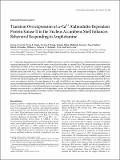| dc.contributor.author | Loweth, Jessica A. | |
| dc.contributor.author | Singer, Bryan F. | |
| dc.contributor.author | Baker, Lorinda K. | |
| dc.contributor.author | Wilke, Georgia | |
| dc.contributor.author | Inamine, Hidetoshi | |
| dc.contributor.author | Bubula, Nancy | |
| dc.contributor.author | Alexander, John K. | |
| dc.contributor.author | Carlezon, William A., Jr. | |
| dc.contributor.author | Vezina, Paul | |
| dc.contributor.author | Neve, Rachael L. | |
| dc.date.accessioned | 2010-06-25T15:51:42Z | |
| dc.date.available | 2010-06-25T15:51:42Z | |
| dc.date.issued | 2010-01 | |
| dc.date.submitted | 2009-11 | |
| dc.identifier.issn | 1529-2401 | |
| dc.identifier.uri | http://hdl.handle.net/1721.1/55966 | |
| dc.description.abstract | Ca[superscript 2+]/calmodulin-dependent protein kinase II (CaMKII) is known to contribute to the expression of psychostimulant sensitization by regulating dopamine (DA) overflow from DA neuron terminals in the nucleus accumbens (NAcc). The present experiments explored the contribution of CaMKII in NAcc neurons postsynaptic to these terminals where it is known to participate in a number of signaling pathways that regulate responding to psychostimulant drugs. Exposure to amphetamine transiently increased {alpha}CaMKII levels in the shell but not the core of the NAcc. Thus, HSV (herpes simplex viral) vectors were used to transiently overexpress {alpha}CaMKII in NAcc neurons in drug-naive rats, and behavioral responding to amphetamine was assessed. Transiently overexpressing {alpha}CaMKII in the NAcc shell led to long-lasting enhancement of amphetamine-induced locomotion and self-administration manifested when {alpha}CaMKII levels were elevated and persisting long after they had returned to baseline. Enhanced locomotion was not observed after infection in the NAcc core or sites adjacent to the NAcc. Transient elevation of NAcc shell {alpha}CaMKII levels also enhanced locomotor responding to NAcc AMPA and increased phosphorylation levels of GluR1 (Ser831), a CaMKII site, both soon and long after infection. Similar increases in pGluR1 (Ser831) were observed both soon and long after exposure to amphetamine. These results indicate that the transient increase in {alpha}CaMKII observed in neurons of the NAcc shell after viral-mediated gene transfer and likely exposure to amphetamine leads to neuroadaptations in AMPA receptor signaling in this site that may contribute to the long-lasting maintenance of behavioral and incentive sensitization by psychostimulant drugs like amphetamine. | en_US |
| dc.language.iso | en_US | |
| dc.publisher | Society for Neuroscience | en_US |
| dc.relation.isversionof | http://dx.doi.org/10.1523/jneurosci.4383-09.2010 | en_US |
| dc.rights | Article is made available in accordance with the publisher's policy and may be subject to US copyright law. Please refer to the publisher's site for terms of use. | en_US |
| dc.source | Society for Neuroscience | en_US |
| dc.title | Transient Overexpression of {alpha}-Ca2+/Calmodulin-Dependent Protein Kinase II in the Nucleus Accumbens Shell Enhances Behavioral Responding to Amphetamine | en_US |
| dc.type | Article | en_US |
| dc.identifier.citation | Loweth, Jessica A et al. “Transient Overexpression of {alpha}-Ca2+/Calmodulin-Dependent Protein Kinase II in the Nucleus Accumbens Shell Enhances Behavioral Responding to Amphetamine.” J. Neurosci. 30.3 (2010): 939-949. © 2010 The Society for Neuroscience | en_US |
| dc.contributor.department | Massachusetts Institute of Technology. Department of Brain and Cognitive Sciences | en_US |
| dc.contributor.approver | Neve, Rachael L. | |
| dc.contributor.mitauthor | Neve, Rachael L. | |
| dc.relation.journal | Journal of Neuroscience | en_US |
| dc.eprint.version | Final published version | en_US |
| dc.type.uri | http://purl.org/eprint/type/JournalArticle | en_US |
| eprint.status | http://purl.org/eprint/status/PeerReviewed | en_US |
| dspace.orderedauthors | Loweth, J. A.; Singer, B. F.; Baker, L. K.; Wilke, G.; Inamine, H.; Bubula, N.; Alexander, J. K.; Carlezon, W. A.; Neve, R. L.; Vezina, P. | en |
| dc.identifier.orcid | https://orcid.org/0000-0002-3854-5968 | |
| mit.license | PUBLISHER_POLICY | en_US |
| mit.metadata.status | Complete | |
